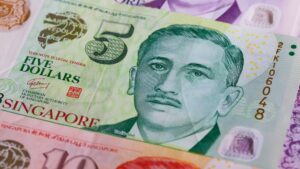Singapore Dollar
 The Singapore dollar is the legal tender of Singapore and is denominated in S$. A dollar can be subdivided into 10 cents (also known as “gross”) or 100 cents. The Singapore dollar can be divided into banknotes and coins. Since 2004, 2 yuan, 5 yuan and 10 yuan plastic banknotes have been issued.
The Singapore dollar is the legal tender of Singapore and is denominated in S$. A dollar can be subdivided into 10 cents (also known as “gross”) or 100 cents. The Singapore dollar can be divided into banknotes and coins. Since 2004, 2 yuan, 5 yuan and 10 yuan plastic banknotes have been issued.
On August 9, 1965, Singapore was forced to withdraw from the Federation of Malaysia and declared its independence.
The Malayan and British Borneo Dollar was established as a republic on December 22nd, but the Malayan and British Borneo Dollar was still used. “In the same year, Singapore began to issue its own banknotes, the Singapore dollar, and four sets of banknotes were issued.
Issuer: Monetary Authority of Singapore
From 1845 to 1939, Singapore used the “Straits dollar” issued by the Straits Settlements as the currency of circulation. After 1940, Singapore followed Malaya to use the Malayan Dollar. During World War II, Singapore used the Japanese military banknotes commonly known as “Banana money” issued by the Japanese military government. The Malayan and British Borneo dollars issued by the Board of Commissioners of Currency, Malaya and British Borneo are 1:1 with the Malayan dollar.
On August 9, 1965, Singapore was forced to become independent, and on December 22, a republic was established, but the Malayan and British Borneo dollars were still used. The legal exchange rate at that time was 60 ringgits equal to 7 pounds.
In 1967, when the British pound depreciated, the original “Malayan and British Peranakan Currency Committee” stopped issuing Malayan and British Peranakan dollars. The Singapore government issued its own Singapore dollar, replacing Malayan and British Peranakan dollars. Po 㑩 Zhou Yuan, the currencies issued at the same time included Singapore dollar, Malaysian ringgit and Brunei dollar, and the currencies of the three countries were equivalent. At that time, the Singapore dollar was 60 Singapore dollars to 7 pounds against the British pound. At this time, the Singapore dollar was still pegged to the British pound, mainly because of the agreement in the Sterling area. The Singapore dollar was briefly pegged to the US dollar. trade exchanges.
According to the “Currency Interchangeability Agreement” signed by Singapore in June 1967, Brunei currency and new currency can be used in the two countries. All Singapore banks are required to accept Brunei banknotes and coins deposited by customers. Any member of the public who receives Brunei currency can take it to a bank and deposit it into a bank account at the same value as the new currency.
From 1973 to 1985, the Singapore dollar began to change with a basket of currencies as the currency exchange rate. After 1985, the Singapore dollar adopted a floating exchange rate system. However, the Monetary Authority of Singapore sometimes controls the currency to stabilize the domestic economy. The issuer of the Singapore dollar was originally issued by the “Singapore Monetary Board”, and was later issued by the Monetary Authority of Singapore on October 1, 2002.